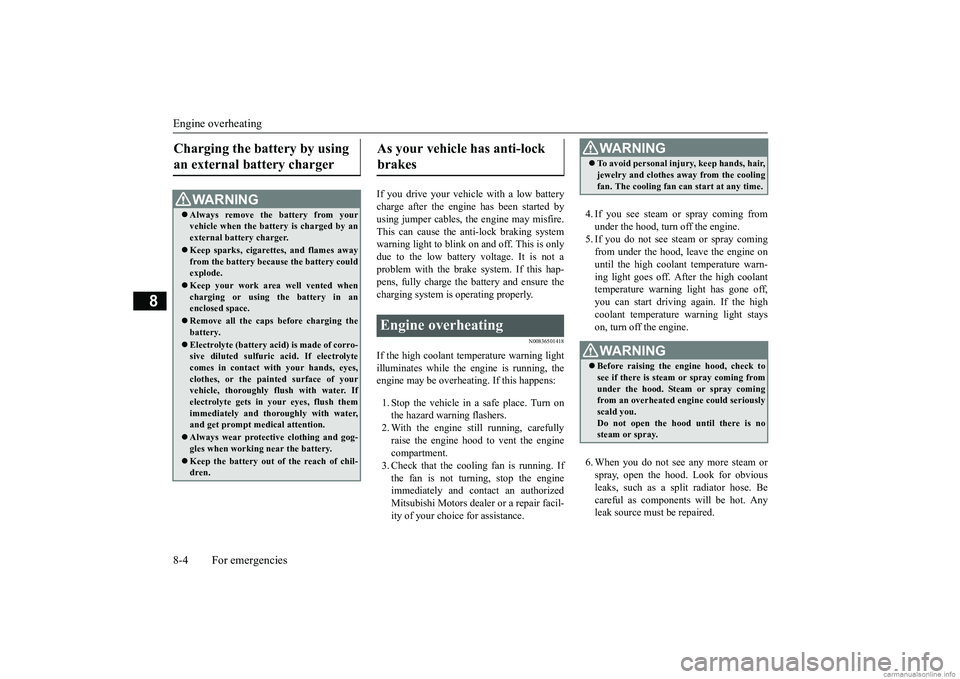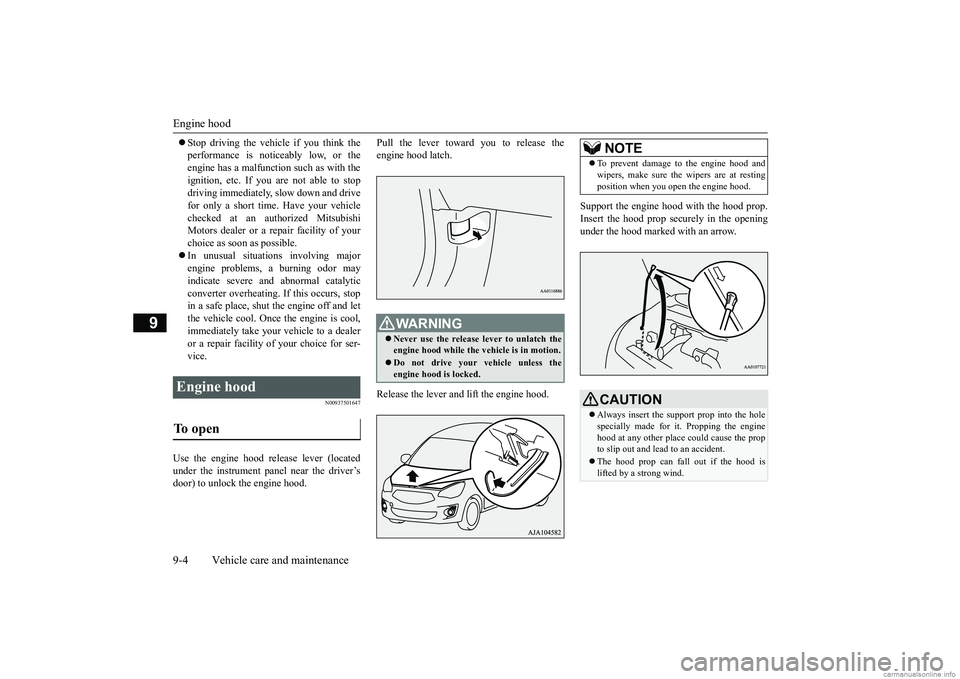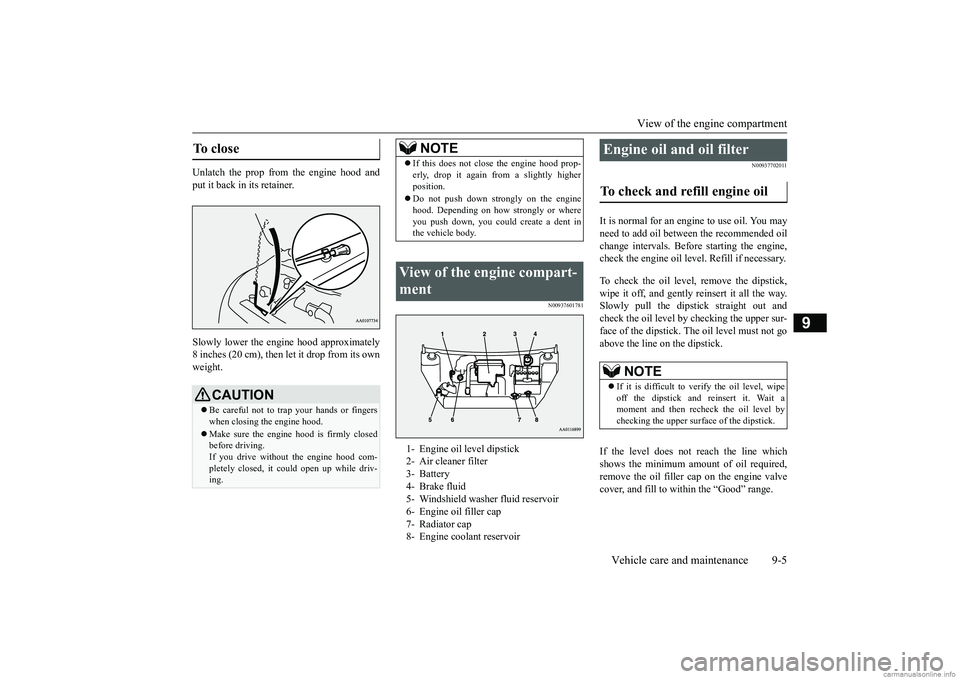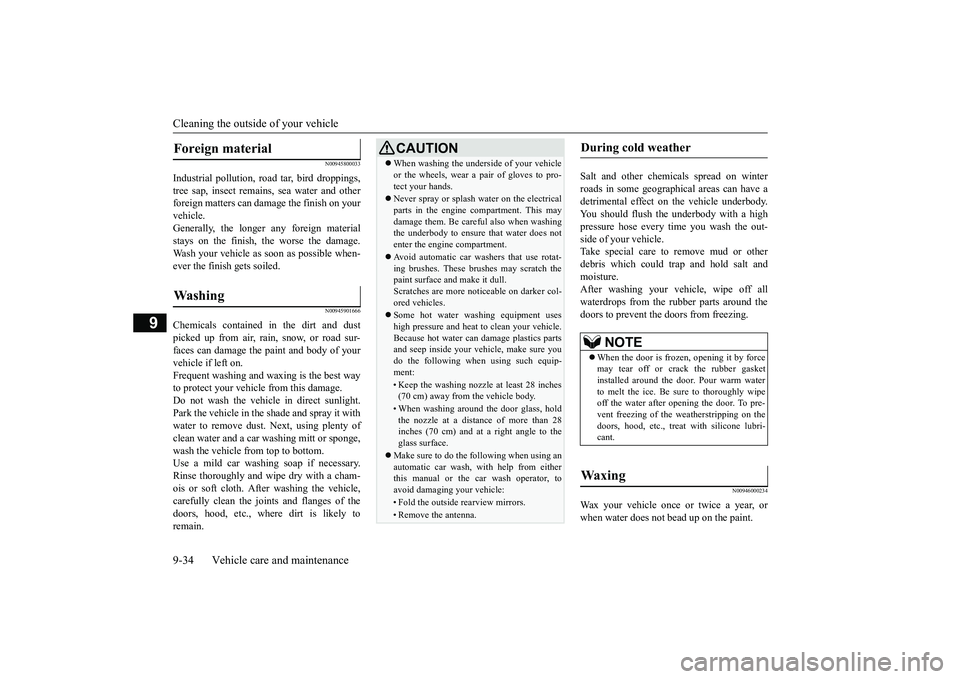hood open MITSUBISHI MIRAGE G4 2019 Owner's Manual (in English)
[x] Cancel search | Manufacturer: MITSUBISHI, Model Year: 2019, Model line: MIRAGE G4, Model: MITSUBISHI MIRAGE G4 2019Pages: 267, PDF Size: 38.31 MB
Page 110 of 267

Continuously variable transmission (CVT) (if so equipped)
Features and controls 5-45
5
Use when engine braking is needed, or for high-power sport drive. This position is for dr
iving up very steep hills
and for engine braking at low speeds when driving down steep hills.
N00549500018 N00574601049
When the selector lever position indicator blinks while you are driving, there could be a malfunction in the automatic transaxle system or CVT fluid temperature becomes abnor- mally high.
“Ds” DOWNSHIFT & SPORTY DRIVING
“L” LOW
WA R N I N G This position can be
used for maximum
engine braking. Be very careful not to shift into “L”(LOW) suddenly. Sudden engine braking may cause the tires to skid.Select this position according to the road conditions and vehicle speed.
When a malfunction occurs in the automatic transaxle
When the selector lever position indicator blinks
NOTE
The “A” indicator blinks only if the CVT selector lever switch is broken.It is not seen during normal driving.
CAUTION If a malfunction occurs in the CVT while driving, the indicator will blink.In this case, immediat
ely park your vehicle
in a safe place and follow these procedures: [If the indicator blinks
rapidly (once per sec-
ond), the CVT fluid is overheating.]Park your vehicle in
a safe place but do not
turn off the engine. M
ove the selector lever
to the “P” (PARK) position and open theengine hood. Keep the engine, idling. After a while, move the selector lever into any position other than
“P” (PARK) position
and confirm that the in
dicator stops blinking.
It is safe to continue driving if the indicator no longer blinks.If the indicator conti
nues blinking, contact
an authorized Mitsubi
shi Motors dealer or
repair facility of your
choice immediately.
[If the indicator blinks slowly (once per 2 seconds), the CVT may
be operating in fail-
safe mode due to a malfunction.]Have the vehicle inspec
ted at an authorized
Mitsubishi Motors dealer
or repair facility of
your choice immediately.
BK0267800US.book 45 ページ 2018年5月30日 水曜日 午後4時24分
Page 199 of 267

Engine overheating 8-4 For emergencies
8
If you drive your vehicl
e with a low battery
charge after the engine has been started byusing jumper cables, th
e engine may misfire.
This can cause the anti-lock braking system warning light to blink on
and off. This is only
due to the low battery voltage. It is not a problem with the brake system. If this hap- pens, fully charge the battery and ensure the charging system is operating properly.
N00836501418
If the high coolant temperature warning lightilluminates while the e
ngine is running, the
engine may be overhea
ting. If this happens:
1. Stop the vehicle in a safe place. Turn on the hazard warning flashers. 2. With the engine still running, carefully raise the engine hood to vent the enginecompartment. 3. Check that the cooling fan is running. If the fan is not turning, stop the engineimmediately and contact an authorized Mitsubishi Motors dealer or a repair facil- ity of your choice for assistance.
4. If you see steam or spray coming from under the hood, turn off the engine. 5. If you do not see steam or spray coming from under the hood, leave the engine onuntil the high coolant
temperature warn-
ing light goes off. After the high coolant temperature warning light has gone off,you can start driving again. If the high coolant temperature warning light stays on, turn off the engine. 6. When you do not see any more steam or spray, open the hood. Look for obviousleaks, such as a split radiator hose. Be careful as components will be hot. Any leak source must be repaired.
Charging the battery by using an external battery charger
WA R N I N G Always remove the
battery from your
vehicle when the battery is charged by an external battery charger. Keep sparks, cigarette
s, and flames away
from the battery because the battery couldexplode. Keep your work area well vented when charging or using
the battery in an
enclosed space. Remove all the caps before charging the battery. Electrolyte (battery acid) is made of corro- sive diluted sulfuric acid. If electrolyte comes in contact with your hands, eyes,clothes, or the pain
ted surface of your
vehicle, thoroughly
flush with water. If
electrolyte gets in your eyes, flush themimmediately and thor
oughly with water,
and get prompt medical attention. Always wear protective clothing and gog- gles when working near the battery. Keep the battery out of the reach of chil- dren.
As your vehicle has anti-lock brakes Engine overheating
WA R N I N G To avoid personal injury, keep hands, hair, jewelry and clothes aw
ay from the cooling
fan. The cooling fan ca
n start at any time.
WA R N I N GBefore raising the en
gine hood, check to
see if there is steam or spray coming fromunder the hood. Steam or spray coming from an overheated en
gine could seriously
scald you.Do not open the hood until there is no steam or spray.
BK0267800US.book 4 ページ 2018年5月30日 水曜日 午後4時24分
Page 215 of 267

Engine hood 9-4 Vehicle care and maintenance
9
Stop driving the vehicle if you think the performance is noticeably low, or theengine has a malfunction such as with the ignition, etc. If you are not able to stop driving immediately,
slow down and drive
for only a short time. Have your vehicle checked at an authorized Mitsubishi Motors dealer or a repair facility of yourchoice as soon
as possible.
In unusual situations involving major engine problems, a burning odor may indicate severe a
nd abnormal catalytic
converter overheating.
If this occurs, stop
in a safe place, shut
the engine off and let
the vehicle cool. Once the engine is cool, immediately take your
vehicle to a dealer
or a repair facility of your choice for ser- vice.
N00937501647
Use the engine hood re
lease lever (located
under the instrument panel near the driver’s door) to unlock the engine hood.
Pull the lever toward you to release the engine hood latch. Release the lever and
lift the engine hood.
Support the engine hood with the hood prop. Insert the hood prop securely in the opening under the hood marked with an arrow.
Engine hood To open
WA R N I N G Never use the release lever to unlatch the engine hood while the
vehicle is in motion.
Do not drive your vehicle unless the engine hood is locked.
NOTE
To prevent damage to the engine hood and wipers, make sure the
wipers are at resting
position when you open the engine hood.CAUTION Always insert the support prop into the hole specially made for
it. Propping the engine
hood at any other place could cause the propto slip out and lead to an accident. The hood prop can fall out if the hood is lifted by a strong wind.
BK0267800US.book 4 ページ 2018年5月30日 水曜日 午後4時24分
Page 216 of 267

View of the engine compartment
Vehicle care and maintenance 9-5
9
Unlatch the prop from the engine hood and put it back in its retainer. Slowly lower the engi
ne hood approximately
8 inches (20 cm), then let it drop from its own weight.
N00937601781
N00937702011
It is normal for an engi
ne to use oil. You may
need to add oil betwee
n the recommended oil
change intervals. Before starting the engine,check the engine oil level. Refill if necessary. To check the oil level, remove the dipstick, wipe it off, and gently
reinsert it all the way.
Slowly pull the dipsti
ck straight out and
check the oil level by checking the upper sur- face of the dipstick. Th
e oil level must not go
above the line on the dipstick. If the level does not reach the line which shows the minimum amo
unt of oil required,
remove the oil filler cap on the engine valve cover, and fill to within the “Good” range.
To close
CAUTION Be careful not to trap your hands or fingers when closing the engine hood. Make sure the engine hood is firmly closed before driving.If you drive without the engine hood com- pletely closed, it c
ould open up while driv-
ing.
NOTE
If this does not clos
e the engine hood prop-
erly, drop it again from a slightly higherposition. Do not push down strongly on the engine hood. Depending on how strongly or whereyou push down, you could create a dent in the vehicle body.
View of the engine compart- ment 1- Engine oil level dipstick 2- Air cleaner filter 3- Battery 4- Brake fluid5- Windshield washer fluid reservoir 6- Engine oil filler cap 7- Radiator cap8- Engine cool
ant reservoir
Engine oil and oil filter To check and refill engine oil
NOTE
If it is difficult to verify the oil level, wipe off the dipstick and
reinsert it. Wait a
moment and then recheck the oil level by checking the upper surfa
ce of the dipstick.
BK0267800US.book 5 ページ 2018年5月30日 水曜日 午後4時24分
Page 221 of 267

Brake fluid 9-10 Vehicle care and maintenance
9
Check the washer fluid
level at regular inter-
vals and add washer fluid to reservoir if nec-essary. Open the reservoir cap and check the level of washer fluid.Full level is approximately 2 inches (5 cm) below from the upper surface of the reservoir. When freezing weather is anticipated, flush out the water in the reservoir by operating the pump. Fill the reservoir with windshield anti-freeze (not radiator an
tifreeze), and operate
the system for a few seconds to flush out the residual water.
N00938701314
The fluid level must be between the “MAX”and “MIN” marks on the reservoir. The fluid level falls slightly with wear of the brake pads, but this
does not indicate any
abnormality. The fluid in the master cylinder should be checked when doing other work under theengine hood. The brake system should also be checked for leaks at the same time. If the fluid level falls
noticeably in a short
length of time, it indi
cates leaks from the
brake system.
If this occurs, have the vehicle checked by an authorized Mitsubishi Motors dealer or arepair facility of your choice. Use the brake fluid conforming to DOT 3 or DOT 4. The reservoir cap must be tightly sealed to keep dirt and water out.
Upper surface Full
Brake fluid To check the fluid level
MAX MIN
Fluid type
WA R N I N G Take care in handling brake fluid as it is harmful to the eyes, may irritates your skin and will damage
painted surfaces.
Wipe up spills immediately. If brake fluid gets on your hands or in your eyes, flush immediately with cleanwater. Follow up with a doctor as neces- sary.CAUTION Do not let any petrol
eum-based fluid touch,
mix with, or get into
the brake fluid. This
will damage the seals. Be careful when handli
ng brake fluid. It can
damage painted surfaces. Use only the listed brake fluid. Different brands of brake fluid
have different addi-
tives, and these can cause a chemical reac- tion. Do not mix brands of brake fluid.
BK0267800US.book 10 ページ 2018年5月30日 水曜日 午後4時24分
Page 233 of 267

For cold and snowy weather 9-22 Vehicle care and maintenance
9
The underside or rear of the vehicle is damaged
Also check the exhaust system each time the vehicle is raised for l
ubrication, oil changes,
or required service. A
ny open seams or loose
connections could le
t dangerous exhaust
fumes seep into the
luggage and passenger
compartments. Check for holes or exhaust gas leaks caused by corrosion or damage. Check the joints and connections for looseness or exhaust gas leaks. Check the rubber hangers and brackets for damage.
N00942500127
The hood lock release mechanism and hood safety catch should be checked, cleaned, andoiled when needed fo
r easy movement and to
prevent rust and wear. Use Multipurpose Grease NLGI Grade 2 sparingly for all slidingparts of the hood latch and release lever. Work the grease into the hood lock mecha-
nism until all the mo
vable surfaces are cov-
ered.Also, put a light coat of the same grease on the safety catch wherev
er moving parts touch.
N00942600102
The ventilation slots in front of the wind- shield should be brushed clear after a heavysnowfall so that the operation of the heating and ventilation systems
will not be impaired.
To prevent freezing of the weatherstripping on the doors, engine hood, etc., they should be treated with
silicone grease.
It is a good idea to carry a shovel or a short- handled spade in the vehicle during the win- ter so that you can clear away snow if you getstranded. A small hand-brush for sweeping
snow off the vehicle a
nd a plastic scraper for
the windshield, side and rear window are alsouseful.
N00942700305
The fusible links will melt to prevent a fire ifa large current attempts
to flow through cer-
tain electrical systems. In case of a melted fusible link, see your authorized Mitsubishi Motors dealer or a repair facility of your
choice for inspection
and replacement. For the fusible links, pl
ease refer to “Fuse
load capacities” on page 9-23.
N00942800902
To prevent damage to the electrical systemfrom short-circuiting
or overloading, each
Check for any of the following conditions: Hood lock release mechanism and safety catch
For cold and snowy weather Ventilation slots Weatherstripping Additional equipment (For regions where snow is encoun- tered)
Fusible links
WA R N I N G Fusible links must not be replaced by any other device. Failing to fit the correct fus- ible link may result in fire in the vehicle,property destruction and serious or fatal injuries at any time.
Fuses Fuse block location
BK0267800US.book 22 ページ 2018年5月30日 水曜日 午後4時24分
Page 245 of 267

Cleaning the outside of your vehicle 9-34 Vehicle care and maintenance
9
N00945800033
Industrial pollution, road tar, bird droppings, tree sap, insect remain
s, sea water and other
foreign matters can damage the finish on yourvehicle. Generally, the longer any foreign material stays on the finish, the worse the damage.Wash your vehicle as soon as possible when- ever the finish gets soiled.
N00945901666
Chemicals cont
ained in the dirt and dust
picked up from air, rain, snow, or road sur-faces can damage the paint and body of your vehicle if left on. Frequent washing and wa
xing is the best way
to protect your vehicl
e from this damage.
Do not wash the vehicle in direct sunlight. Park the vehicle in the shade and spray it withwater to remove dust.
Next, using plenty of
clean water and
a car washing mitt or sponge,
wash the vehicle from top to bottom.Use a mild car washing soap if necessary. Rinse thoroughly and wipe dry with a cham- ois or soft cloth. After washing the vehicle,carefully clean the joints and flanges of the doors, hood, etc., wher
e dirt is likely to
remain.
Salt and other chemicals spread on winter roads in some geographical areas can have a detrimental effect on the vehicle underbody.You should flush the underbody with a high pressure hose every time you wash the out- side of your vehicle.Take special care to
remove mud or other
debris which could trap and hold salt and moisture. After washing your vehicle, wipe off all waterdrops from the rubber parts around thedoors to prevent the doors from freezing.
N00946000234
Wax your vehicle once or twice a year, orwhen water does not bead up on the paint.
Foreign material Wa s h i n g
CAUTION When washing the underside of your vehicle or the wheels, wear a pair of gloves to pro-tect your hands. Never spray or splash
water on the electrical
parts in the engine compartment. This maydamage them. Be careful also when washing the underbody to ensure that water does not enter the engine compartment. Avoid automatic car washers that use rotat- ing brushes. These brushes may scratch thepaint surface and make it dull. Scratches are more not
iceable on darker col-
ored vehicles. Some hot water wash
ing equipment uses
high pressure and heat to clean your vehicle.Because hot water can da
mage plastics parts
and seep inside your ve
hicle, make sure you
do the following when using such equip-ment:• Keep the washing nozzle at least 28 inches(70 cm) away from the vehicle body.• When washing around the door glass, holdthe nozzle at a distance of more than 28 inches (70 cm) and at a right angle to the glass surface.
Make sure to do the following when using an automatic car wash, with help from eitherthis manual or the car wash operator, to avoid damaging your vehicle:• Fold the outside rearview mirrors.• Remove the antenna.
During cold weather
NOTE
When the door is frozen, opening it by force may tear off or crack the rubber gasket installed around the door. Pour warm water to melt the ice. Be sure to thoroughly wipeoff the water after opening the door. To pre- vent freezing of the we
atherstripping on the
doors, hood, etc., treat with silicone lubri-cant.
Waxing
BK0267800US.book 34 ページ 2018年5月30日 水曜日 午後4時24分